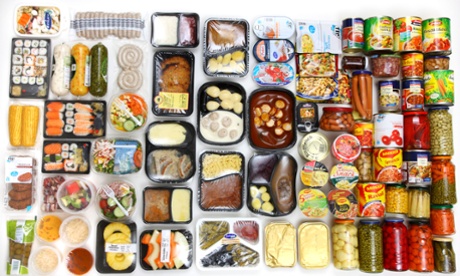
Food giant Kellogg is removing the genetically modified ingredients from its Kashi Golean cereals. Competitor ConAgra is launching a line of minimally processed frozen meals under the brand name Healthy Choice Simply. And General Mills last fall snapped up Annie’s, a popular brand of organic pastas, snacks and condiments.
As consumer demand for local, organic and fresh foods continues to grow, the enormous multinational firms that are collectively being called Big Food are in the position of having to rework, reshape and reimagine themselves. Although this changing consumer landscape has contributed to lackluster growth among some of the industry’s major players, the consensus among producers, analysts and healthy food advocates is that the major food companies – and their influence – are still going strong. For now.
“These companies make billions of dollars every year. The issue isn’t profits – these are massive – it’s growth,” says Marion Nestle, professor of nutrition and food studies at New York University, and an advocate for healthy food policy.
Indeed, growth has been a challenge for many in the industry over the past year.
Net sales at Kellogg – maker of Cheez-Its, Pringles and Keebler cookies in addition to its well-known cereals – decreased by 1.4% to $14.6b in 2014, a performance CEO John Bryant called “disappointing” in the company’s fourth quarter earnings call. Declining sales of breakfast foods and snacks contributed to the downward trend. At Kraft – home of brands including Oscar Mayer, Jell-O and Velveeta – net revenues edged down 0.1% in 2014.
Consumers’ growing appetite for foods that feel healthier, fresher and less processed is one of the significant obstacles to growth. In remarks at the Consumer Analyst Group of New York conference in February, Campbell’s CEO Denise Morrison said: “we are also confronting profound shifts in consumers’ preferences and priorities with respect to food”, pointing to an “explosion of interest in fresh foods” and “a mounting distrust of so-called Big Food”.
Sales on the perimeter of the supermarket, where fresh produce, meat and dairy are generally sold, have risen about 5% over the last year, while sales of the more processed and packaged items sold in the aisles have increased only 1%, says Erin Lash, food industry analyst for investment research firm Morningstar.
“Consumers just want to overall feel like they are eating healthier,” Lash says. “That’s one of the biggest trends, especially in the US.”
Big food companies have seen some of these changes coming and attempted to prepare for them. Kellogg acquired whole-grains-focused Kashi in 2000, the same year General Mills bought organic food company Small Planet Foods, which produces Cascadian Farms vegetables and Muir Glen tomatoes.
“We have a strong portfolio of natural and organic brands, which has been growing double digits since [the Small Planet acquisition],” says General Mills spokeswoman Bridget Christenson, valuing the company’s natural and organic portfolio at $600m.
The trend shows no signs of slowing, with plenty of examples of big companies redoubling their investments in healthy food initiatives.
Nestlé USA announced last month that it will stop using artificial colors in its chocolates by the end of 2015. ConAgra has been expanding its “all-natural, gourmet-inspired” Alexia brand, adding frozen vegetables, side dishes and breads to the line. Campbell’s launched an organic soup line last month, and Morrison, in her remarks at the analyst conference, promised an investment in “packaged fresh” foods.
At the same time, while fresher, healthier foods may be grabbing more room in the lineup, there is reason to believe that the appetite for convenient packaged foods remains strong. Kraft’s fourth quarter earnings release (pdf) points to increased sales of Lunchables prepackaged lunches and “ongoing growth in bacon” as key factors driving higher revenues in its refrigerated meals category. Sales of Pringles are increasing, Kellogg’s Bryant said at the analysts conference. ConAgra’s pot pies and Chef Boyardee canned pastas are both seeing increased sales.
“People who don’t consume Chef Boyardee might comment on the processed nature of it, but when we talk to people who depend on that product, it’s something that they dramatically love,” says Thatcher Schulte, ConAgra’s director of insights and analytics.
The future, as always, is uncertain. And it’s unlikely all the companies’ efforts will share the same fate. After all, some companies have done a better job of positioning themselves than others. Lash points to Kellogg and Campbell’s as two companies that have struggled. Kraft, on the other hand, has been doing a good job refocusing its marketing efforts, and General Mills is getting some traction with its Greek yogurt offerings, she says.
Lash says that the future looks bright for those that are willing to adapt: “The companies that you see that are focused on innovation, focused on bringing to market new products – they have the opportunity to continue to realize decent growth.”
The food hub is funded by The Irish Food Board. All content is editorially independent except for pieces labelled “brought to you by”. Find out more here.

